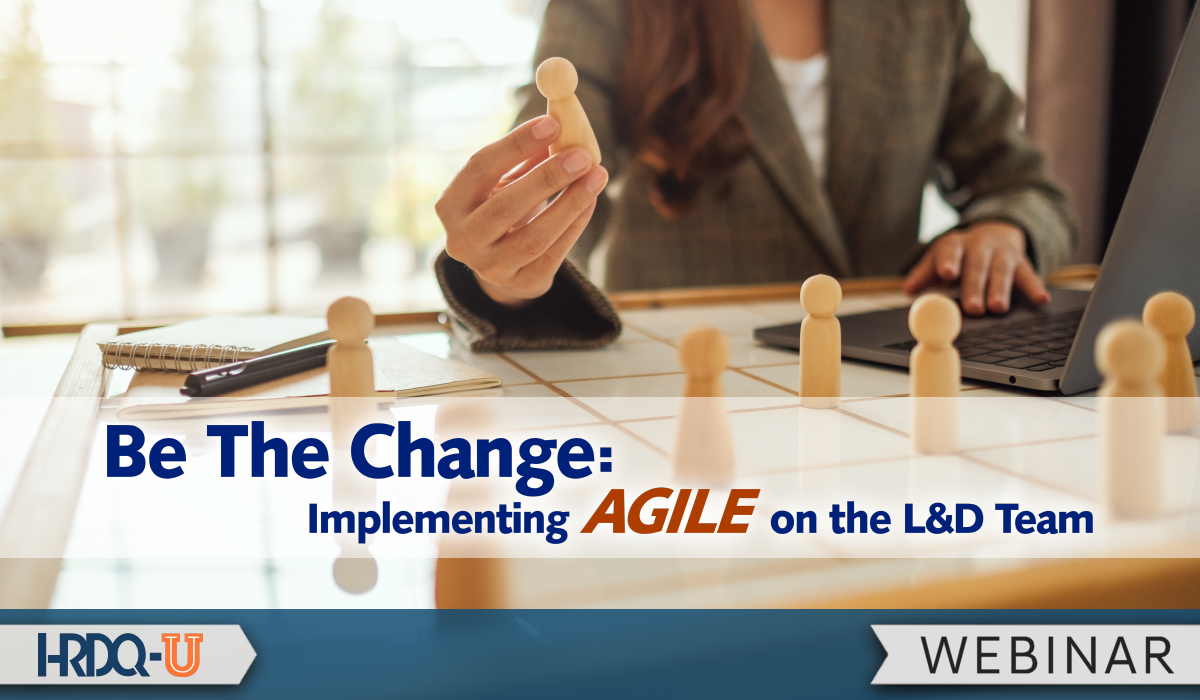- 827 Lincoln Ave. #B-10 West Chester, PA 19380
- support@hrdq.com
- +1-610-279-2002
Quick Links
Menu
Featured Topics
Menu
Total Results
We could not find what you're looking for. Please try again.No Record Found

Agile is renowned for its adaptability and responsiveness; it provides a framework for adapting to change. By working closely with project sponsors, we ensure the delivery of implementing Agile is precisely what learners truly need. In a rapidly changing environment, the Agile mindset helps us harness change for good rather than resist it. The Agile techniques offer solutions for making constant change a practical reality. Rapid iterative cycles of design and evaluation allow us to test our solutions before full implementation, opening the doors to constructive change along the way.
And yet, software development projects face different challenges and have different needs than instructional design projects. Strictly implementing Agile methods may not apply to your L&D work, and you’ll need to thread that needle as you implement this on your team.
In this session, we’ll take a change management approach to what it takes to implement Agile – the LLAMA® approach – in L&D teams. We’ll start by identifying a business case for change and getting buy-in from leaders, stakeholders, and your team. We’ll then look at preparing the team’s skill sets and roles before turning to the processes and tools you’ll need for a successful rollout to start implementing Agile. Of course, along the way, you’ll see how to take an Agile approach to your Agile implementation, picking a first team and a first project for your new process. Additionally, we will equip you with the Agile skills necessary to embrace this transformative challenge confidently.


Agile project management course
Are you looking to enhance your Agile project management skills and stay ahead of the curve? Join presenter Megan Torrance for the exciting workshop Foundations of LLAMA – Agile Project Management for Instructional Design Teams, and discover a world of efficient and results-driven techniques.
Receive 20% off this workshop. Mention code LLAMA20HRDQ at registration.
Megan Torrance is the CEO and founder of TorranceLearning, connecting learning strategy to design, development, data, and ultimately performance. Megan has over 25 years of experience in learning design, deployment, and consulting. Megan and the TorranceLearning team are passionate about sharing what works, so they devote considerable time to teaching and sharing how to implementing Agile project management for learning design, racial equity, and xAPI & learning analytics.
Megan is the author of Agile for Instructional Designers, Data & Analytics for Instructional Designers, and Making Sense of xAPI. She is also a Facilitator with eCornell’s Women’s Executive Leadership certificate and courses in virtual teaming, team leadership, and communication.
TorranceLearning is a full-stack learning services firm, supporting workplace learning from strategy to custom design & development all the way through custom software, xAPI deployment, and learning analytics. We do things differently! We thrive on adapting to changing needs throughout a project as a way to harness innovation & curiosity for the learner’s benefit.
Training Tools for Developing Great People Skills
This event is sponsored by HRDQ. For 45 years HRDQ has provided research-based, off-the-shelf soft-skills training resources for classroom, virtual, and online training. From assessments and workshops to experiential hands-on games, HRDQ helps organizations improve performance, increase job satisfaction, and more.
Learn more at HRDQstore.com
“This webinar was very useful for anyone interested in or for building their Agile instructional design skills.”
– Michael G.
“Enjoyed today’s presenter! She was so dynamic and knowledgeable of the topic. Walked away with some golden nuggets, looking forward to leveraging them soon!”
– Massiel L.
“Megan was knowledgeable and engaging; the information she provided was insightful, especially the agile readiness assessment.”
– Enid R.

Sign up to be notified of upcoming live webinars, in-depth workshops, podcasts, blog posts, promotions and much more. Stay ahead of the curve and subscribe for FREE today!